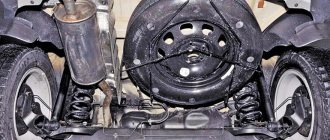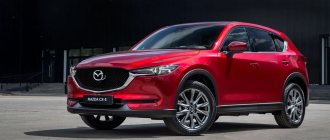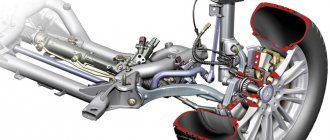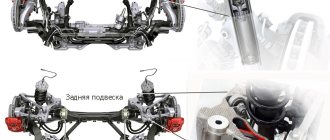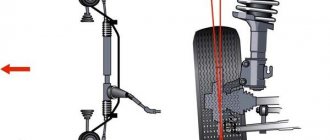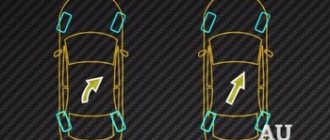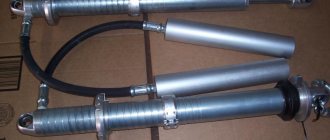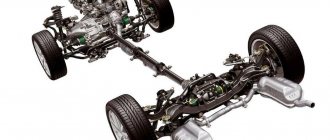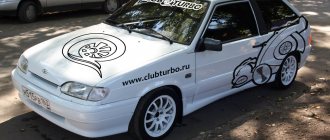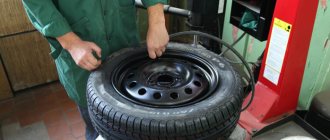Suspension experts can tell you many interesting examples from practice, but I will have to limit myself to just a brief story about why harder is not always more grippy, and softer is not always more comfortable. The operation of car suspensions is not at all as simple as it seems at first glance. They perform many functions that are not entirely obvious. I will try to briefly mention the main ones.
In general, many books have been written about the work of pendants, and most of them are very thick. I will only try to outline the main points in order to fit into the format of an informative article.
Why you can't do without a pendant
Even very smooth roads actually have a curve in many directions, and the Earth itself bears little resemblance to an infinite plane. And in order for all four wheels to touch the surface, they must be able to move up and down. In this case, it is extremely desirable that the running surface of the wheel adheres to the surface with its entire width in any position of the suspension. So cars with stiff and short-travel suspensions are practically doomed to have poor wheel grip on the road, because one of the wheels will always be unloaded.
Why should the suspension have compression travel?
For all wheels to contact the road, it is not at all necessary that the suspension can be compressed; it is enough that the wheels can only move down. But when the car moves in turns, lateral forces arise that tend to tilt the car. If at the same time one side of the car can rise, and the other cannot lower, the center of gravity of the car will greatly shift towards the loaded wheel, which in turn will cause many negative consequences.
First of all, an even greater unloading of the internal wheel in relation to the rotation and an increase in the roll moment due to the movement of the center of gravity upward relative to the center of the suspension roll (more about it below). And, of course, if the wheels have no compression stroke, then even a small bump under one of the wheels should cause the body to move, moving all the other wheels down with all the associated energy costs of lifting and reduced wheel traction. Which, to put it mildly, is not very comfortable. It is also destructive to the body and suspension parts. In general, the suspension must be balanced, have compression travel and rebound travel to function properly.
Why does the car roll when cornering?
Since we have decided that the car should have a suspension and can move up and down, then purely geometrically a certain point, a center, is formed around which the car body rotates when it rolls. This point is called the vehicle's roll center.
And the sum of the inertial forces acting on the car during a turn is precisely applied to its center of mass. If it coincided with the roll center, then there would be no roll during the turn, but it is usually located much higher, and as a result, a rolling moment is formed. And the higher the roll center is, the lower the center of gravity, the smaller it is. On special racing designs like Formula 1 cars, the center of gravity is placed below the roll center, and then the car can roll in the opposite direction, like a boat on the water.
Actually, the location of the roll center depends on the suspension design. And automobile engineers have learned quite well how to “raise” it higher by changing the design of the levers, which in theory could eliminate roll not only from low sports cars, but also from quite tall ones. The problem is that the suspension, designed to provide an “unnaturally raised” roll center, successfully combats body lean, but does not do a good job of its main task - damping bumps.
Why should the suspension be soft?
It is quite obvious that the softer the suspension, the less the change in body position when hitting a bump and the less the load is distributed between different wheels when rolling. This means that the grip of the wheels on the road does not deteriorate and energy is not wasted on moving the center of mass of the car up and down. Well, have we found the perfect formula? But, unfortunately, not everything is so simple.
Firstly, suspensions have limited compression strokes, and they must be coordinated with the change in axle load when the car is loaded with passengers and luggage, and with the load that arises when cornering and bumps. A suspension that is too soft will compress so much when turning that the wheels on the other side will lift off the ground. So the suspension must prevent the compression stroke on one side from being exhausted and the wheel hanging out on the other.
It turns out that it is also bad for a suspension to be too soft... The optimal option is a relatively small range of “softness”, after which the suspensions become hard, but adjusting such a design is more difficult, the higher the difference between its hard and soft parts.
With any redistribution of load between the wheels, the overall grip of the wheels with the road deteriorates. The fact is that additional loading of some wheels does not compensate for all losses when unloading others. And in the case of hanging unloaded wheels, the increase in traction on the loaded side does not compensate for even half of the losses.
In addition to the general deterioration of grip, this also leads to deterioration in handling. They combat this unpleasant factor by changing the inclination of the rolling plane of the wheel relative to the road - the so-called camber. As a result of design measures aimed at programming changes in camber when the machine rolls, it is possible to compensate for changes in wheel adhesion under lateral loads within a reasonable range and thereby make driving the machine easier.
Why do we have to make suspensions stiffer on sports cars?
The car's handling is extremely negatively affected by any changes in the suspension angles when the car rolls and delays in responses to control inputs due to a shift in the center of gravity. This means that the suspension has to be made stiffer to reduce roll when turning.
The extreme solution is a powerful anti-roll bar - a torsion bar, which prevents the wheel of one axle from moving relative to the other. But this is not the best way. Yes, it improves the situation with changing wheel alignment angles in a turn, but it unloads the inner wheel in relation to the turn, and overloads the outer one. It's a little better to just stiffen the suspension. This has a greater effect on comfort, but does not relieve the inner wheel as much.
Considerable importance of shock absorbers
In addition to elastic elements, the car’s suspension also contains gas or liquid shock absorbers - elements responsible for damping suspension vibrations and removing the energy that the car spends on moving the center of mass. With their help, you can correct all suspension reactions to compression and rebound, because a shock absorber can provide much greater rigidity in dynamics than a spring. Moreover, its stiffness, unlike springs, will be very different depending on the travel of the suspension and the speed of its movement.
Of course, a very soft shock absorber will not be able to fulfill its main task - damping vibrations; the car will simply sway after passing a bump. And installing a very stiff one will create an effect similar to installing a very stiff spring that does not want to compress and thereby increases the load on the wheel and unloads all the others. But fine tuning will help reduce roll in corners and help the springs, reduce body dive during acceleration and braking, and at the same time not interfere with the wheels going over small bumps. And of course, avoid “breakdown” of the suspension when driving over hard bumps. In general, they have no less impact on the behavior of the car than the stiffness of the springs.
German cars turned out to be not the most reliable in terms of suspension, but the Japanese ones are the best
The rating is based on the most affordable used cars of different classes - from compact to luxury
The class of the car and its cost have little to do with the durability of the suspension. Are you surprised? We are not. According to the latest rating of car malfunctions, this time compiled by Polish mechanics, city and compact class cars have the most durable suspension. At least the Poles were convinced of this on their city roads.
Worn joints, shock absorbers, damaged bearings, corrosion - all these, according to mechanics, are the most common malfunctions in car suspension systems.
The worst in terms of suspension durability were French cars , the best were Japanese cars (we emphasize that we are most likely talking about “left-hand drive” models, with “right-hand drive” cars the quality should be even higher). With German cars, not everything is so simple. Some models turned out to be invigorating, others are better not to take.
Cracks in the suspension links, leaking shock absorbers, the car pulls to the side or the rear axle begins to steer in turns - problems with the suspension manifest themselves in different ways. Unfortunately, many drivers often underestimate the seriousness of the situation. Serious problems arise when you need to make a sudden, sharp maneuver to avoid hitting an obstacle or avoid a collision. It is at the moment of overload that a final breakdown can occur. In this case, keeping the car on the road will be problematic, and the scenario of emerging victorious from the situation is sharply painted in black colors.
Polish experience useful for Russian motorists
According to colleagues from Poland, the average condition of the suspension on cars operated in the country can be assessed as 4.1 points on a 6-point scale. According to mechanics, the most common problems in a typical car are worn joints, shock absorbers, damaged bearings and corrosion.
Cars with the most unreliable types of suspension
There were also many other surprises in the ranking. For example, the most popular models on the market are the Volkswagen Passat B5 (it has a fairly reliable suspension, but its complex front architecture and the cost of repairs reduce all comfort to nothing), Audi A4 (B6 and B7) and Audi A6 (C5) took places closer to bottom of the list, only 45th place or so. The weak positions in the suspension strength rating are complemented by the third generation Ford Mondeo (47th place) and Peugeot – 207.407 and 307 (39th place).
Hyundai Elantra XD
The third generation of the Korean model has become a successful compromise between outright cheapness and a truly high world-class level. Consequently, with a relative simplicity of design and reliability, the Hyundai Elantra pleases with a well-assembled interior, decent sound insulation and engines with a power of up to 140 hp.
The latter provide good dynamics and are quite reliable at the same time. The suspension can withstand driving on bad roads, despite knocking noises that appear quite early, which, however, can be driven for a long time if you do not pay attention to the noise.
Cars with the most reliable suspension
Toyota Yaris turned out to be a city car with the most durable suspension. The second generation of this model took first place with an average rating of 4.9, and the second position belongs to its successor. Right behind them stood the Honda Civic VIII and Volkswagen Golf VI .
A quick look at the rating (and based on it), we can conclude that Japanese cars have the best suspensions. Five cars from the homeland of sakura made it into the top ten.
The best and worst sound insulation of a car
The German magazine Autobild and its employees conducted noise insulation tests in 2011. Measurements of the noise level in the car interior were carried out with special instruments with the windows closed and at a speed of 130 km/h.
Worst car sound insulation (TOP 10):
It is worth paying attention to the fact that the TOP 10 cars with the worst noise insulation included sports cars, except for the Niva 4x4 and Renault Twingo.
Offer from CosCar.Ru
Defender AeroEffect
The use of Defender Aeroeffect sprayed sound insulation for the VAZ 4x4 Niva will reduce noise by a noticeable 6 dB.
This product has no analogues and allows not only to reduce noise and vibration in the interior of one of the noisiest cars, but also to protect the arches and underbody of the car from corrosion.
- WATCH THE VIDEO Example of application of Defender AeroEffect
The best sound insulation of cars (TOP 10):
“Small cars” were in the ranking with average indicators. The sound insulation of cars of this type cannot be called good, despite the small engine size:
Rating of cars with good factory sound insulation:
With all the above indicators, it is worth considering that not all motorists drive at a speed of 130 km/h. Also, the brands of tires used during testing were not indicated.
A car that’s more expensive doesn’t mean it’s better?
Among cars costing up to 10,000 zlotys (167 thousand rubles), Audi A3 8L with the highest score - 4.5 . This model had the fewest suspension failures, and when they did occur, they were mostly due to problems with individual suspension components. The lowest score (3.5) in this price range was received by the Volkswagen Passat B5 . The latter most often had difficulties with the suspension and wheel bearings.
In the range from 10 to 20 thousand zlotys (167-335 thousand rubles) Toyota Yaris II (4.9) had no equal. Its suspension turned out to be the best in the entire rating. The mechanics did not find any faults in this model. The worst performer in the price group considered was the Audi A4 (B6 and B7) (3.7). Both auto mechanics and car owners do not like it: it often breaks down and often requires intervention.
Among the most expensive cars included in the rating (price range from 335 thousand rubles to 500 thousand rubles), the best result (4.8), as in the second group, was taken by Toyota Yaris, only a newer model - 3rd generation . A high rating does not mean, however, that the car's suspension is problem-free. Among the difficulties in operating this model were mentioned, for example, damage to bearings or cracking of springs. The big loser in this group is the Renault Mégane III (3.5), which is also the model with the lowest suspension score in the entire ranking.
Let's talk this time about which suspension is better: soft or hard. Let's figure out what the differences are. We'll tell you why the choice of suspension depends on the goals you pursue when buying a car. For rigidity does not always keep pace with tenacity, and softness with comfort.
The best car sound insulation according to owner reviews
You can leave your review about the sound insulation of your car on the website otzyvnoy.ru. As a result, using filters you can find out, for example, which crossover has good sound insulation (here you can see the direct dependence of the quality of sound insulation on the price of the car) or build a car sound insulation rating by country:
- The loudest cars are made in Russia, rating 21%.
- The Chinese are slightly ahead (Great Wall, Chery, Lifan, Geely), rating 26%.
- Japan (Honda, Mazda, Mitsubishi, Nissan, Toyota, etc.), rating 31%.
- South Korea (Daewoo, Hyundai, Kia, SsangYong), rating 37%.
- USA (Chevrolet, Ford), rating 41%.
- France (Citroen, Peugeot, Renault), rating 60%
- Germany (Audi, Mercedes Benz, Opel, Volkswagen), rating 69%.
- The best noise insulation was found in UK cars (Bentley, Jaguar, Land Rover, Rover), with a rating of 81%.
It's worth keeping in mind that this is a general indicator, and if Japan doesn't have the best ranking on this list, then don't underestimate the Lexus' sound insulation. To determine which car has the best sound insulation, you should look at the ratings by brand, or even better, by specific car models. Based on the results of noise insulation ratings from various sources, it can be said that an obvious difference can be seen between sports cars and cars for everyday driving, domestic VAZ cars and foreign cars, business class cars and cars of the small/medium price category.
If you try to find out among the rating participants which cars have the best sound insulation, then the leaders can be called:
- BMW 750i
- Lexus ES 250
- Mercedes Benz E200
- Audi A6
- Skoda Octavia A7
The noisiest were:
- LADA Granta
- Skoda Octavia A5
- Ford Focus III
- Skoda Octavia Tour
- Volvo XC V70
In general, it seems that automakers can make cars quieter, but do not specifically do this, stopping at a certain level.. The long-established opinion that VAZ cars have poor noise insulation was once again confirmed in the rating of Niva 4x4 and Lada Granta (modern AvtoVAZ model) are at the very end of the list. Only additional sound insulation improves the situation a little.
I made a Shvi VAZ 2110 and
Keywords:
- complete sound insulation of the car
Car sound insulation is an integral part of car comfort. Of course, cars with good sound insulation bring your car closer to the status of prestige and high cost. In this article we will look at the rating of cars with good and poor noise insulation.
The essence of the suspension
First, let's look at what functions any suspension should perform:
- reduce roll when turning;
- be one mechanism inseparable from the car during emergency braking or a collision;
- ensure smooth running of the machine;
- maintain clear alignment angles of car wheels;
- effectively and quickly dampen body vibrations while driving over potholes, bumps, speed bumps, etc.
In order for all 4 wheels to stand confidently on the road surface, they must be able to move up and down and touch the entire width of the road. Adjusting the springs helps make the suspension softer or stiffer. Shock absorbers also play a significant role.
Trunk jump with things
However, braking can still be useful in some situations. If cans and other fragile utensils are carried in the trunk, which risk breaking when bouncing on a speed bump, then the rear axle should be “pressed down” by lightly touching the brake pedal. This is done when the front wheels have already passed the bump, but the rear wheels have not yet reached it. Braking helps shift the weight of the car forward and relieve the shock absorbers at the rear, as well as preventing the rear from jumping. In this case, the rear suspension will meet the impact fully and will be able to absorb the energy as much as its design allows. True, to learn how to lift the stern on a speed bump, you need to develop a skill.
Shock absorbers
These suspension elements are responsible for damping vibrations. That is, the roll, as well as the movement of the body when driving on an uneven road, depends on their settings. A shock absorber can make the suspension stiff but flexible. There is no need to adjust it too softly - the car will swing like a pendulum. It’s also not necessary to be harsh: the car will “collect” the smallest roughness of the road surface. Competent car mechanics can adjust the shock absorbers so that there will be less roll and “dive” during acceleration and braking. Moreover, the suspension will not respond to the driver’s back at the slightest hole and will not break through if the driver finds himself in a deep puddle.
Next, let's talk about the hard-tuning suspension, its pros and cons.
Operation in Russia
Our compatriots cannot specifically determine which is the best suspension for Russian roads. It all depends on the purpose for which you take it, what you expect from it, and what price range it is from. Your driving style also greatly influences your choice. The best car suspension is the one with which you will feel confident on the road and comfortable in the cabin. For the transportation and delivery of goods, it is better to use a more durable suspension, that is, torsion bar or even spring. For daily driving around the city in a small car or economy class car, you can choose a MacPherson spring suspension or a single wishbone. The business class, naturally, is accustomed to comfort; for them, a multi-link independent suspension will be an excellent basis for a comfortable ride.
Make a choice only in the right direction, and, as they say, neither nail nor rod!
Suspension experts can tell you many interesting examples from practice, but I will have to limit myself to just a brief story about why harder is not always more grippy, and softer is not always more comfortable. The operation of car suspensions is not at all as simple as it seems at first glance. They perform many functions that are not entirely obvious. I will try to briefly mention the main ones.
In general, many books have been written about the work of pendants, and most of them are very thick. I will only try to outline the main points in order to fit into the format of an informative article.
Why you can't do without a pendant
Even very smooth roads actually have a curve in many directions, and the Earth itself bears little resemblance to an infinite plane. And in order for all four wheels to touch the surface, they must be able to move up and down. In this case, it is extremely desirable that the running surface of the wheel adheres to the surface with its entire width in any position of the suspension. So cars with stiff and short-travel suspensions are practically doomed to have poor wheel grip on the road, because one of the wheels will always be unloaded.
1 / 2
2 / 2
Why should the suspension have compression travel?
For all wheels to contact the road, it is not at all necessary that the suspension can be compressed; it is enough that the wheels can only move down. But when the car moves in turns, lateral forces arise that tend to tilt the car. If at the same time one side of the car can rise, and the other cannot lower, the center of gravity of the car will greatly shift towards the loaded wheel, which in turn will cause many negative consequences.
First of all, an even greater unloading of the internal wheel in relation to the rotation and an increase in the roll moment due to the movement of the center of gravity upward relative to the center of the suspension roll (more about it below). And, of course, if the wheels have no compression stroke, then even a small bump under one of the wheels should cause the body to move, moving all the other wheels down with all the associated energy costs of lifting and reduced wheel traction. Which, to put it mildly, is not very comfortable. It is also destructive to the body and suspension parts. In general, the suspension must be balanced, have compression travel and rebound travel to function properly.
Why does the car roll when cornering?
Since we have decided that the car should have a suspension and can move up and down, then purely geometrically a certain point, a center, is formed around which the car body rotates when it rolls. This point is called the vehicle's roll center.
And the sum of the inertial forces acting on the car during a turn is precisely applied to its center of mass. If it coincided with the roll center, then there would be no roll during the turn, but it is usually located much higher, and as a result, a rolling moment is formed. And the higher the roll center is, the lower the center of gravity, the smaller it is. On special racing designs like Formula 1 cars, the center of gravity is placed below the roll center, and then the car can roll in the opposite direction, like a boat on the water.
Actually, the location of the roll center depends on the suspension design. And automobile engineers have learned quite well how to “raise” it higher by changing the design of the levers, which in theory could eliminate roll not only from low sports cars, but also from quite tall ones. The problem is that the suspension, designed to provide an “unnaturally raised” roll center, successfully combats body lean, but does not do a good job of its main task - damping bumps.
Why should the suspension be soft?
It is quite obvious that the softer the suspension, the less the change in body position when hitting a bump and the less the load is distributed between different wheels when rolling. This means that the grip of the wheels on the road does not deteriorate and energy is not wasted on moving the center of mass of the car up and down. Well, have we found the perfect formula? But, unfortunately, not everything is so simple.
Firstly, suspensions have limited compression strokes, and they must be coordinated with the change in axle load when the car is loaded with passengers and luggage, and with the load that arises when cornering and bumps. A suspension that is too soft will compress so much when turning that the wheels on the other side will lift off the ground. So the suspension must prevent the compression stroke on one side from being exhausted and the wheel hanging out on the other.
It turns out that it is also bad for a suspension to be too soft... The optimal option is a relatively small range of “softness”, after which the suspensions become hard, but adjusting such a design is more difficult, the higher the difference between its hard and soft parts.
With any redistribution of load between the wheels, the overall grip of the wheels with the road deteriorates. The fact is that additional loading of some wheels does not compensate for all losses when unloading others. And in the case of hanging unloaded wheels, the increase in traction on the loaded side does not compensate for even half of the losses.
In addition to the general deterioration of grip, this also leads to deterioration in handling. They combat this unpleasant factor by changing the inclination of the rolling plane of the wheel relative to the road - the so-called camber. As a result of design measures aimed at programming changes in camber when the machine rolls, it is possible to compensate for changes in wheel adhesion under lateral loads within a reasonable range and thereby make driving the machine easier.
Why do we have to make suspensions stiffer on sports cars?
The car's handling is extremely negatively affected by any changes in the suspension angles when the car rolls and delays in responses to control inputs due to a shift in the center of gravity. This means that the suspension has to be made stiffer to reduce roll when turning.
The extreme solution is a powerful anti-roll bar - a torsion bar, which prevents the wheel of one axle from moving relative to the other. But this is not the best way. Yes, it improves the situation with changing wheel alignment angles in a turn, but it unloads the inner wheel in relation to the turn, and overloads the outer one. It's a little better to just stiffen the suspension. This has a greater effect on comfort, but does not relieve the inner wheel as much.
Considerable importance of shock absorbers
In addition to elastic elements, the car’s suspension also contains gas or liquid shock absorbers - elements responsible for damping suspension vibrations and removing the energy that the car spends on moving the center of mass. With their help, you can correct all suspension reactions to compression and rebound, because a shock absorber can provide much greater rigidity in dynamics than a spring. Moreover, its stiffness, unlike springs, will be very different depending on the travel of the suspension and the speed of its movement.
Of course, a very soft shock absorber will not be able to fulfill its main task - damping vibrations; the car will simply sway after passing a bump. And installing a very stiff one will create an effect similar to installing a very stiff spring that does not want to compress and thereby increases the load on the wheel and unloads all the others. But fine tuning will help reduce roll in corners and help the springs, reduce body dive during acceleration and braking, and at the same time not interfere with the wheels going over small bumps. And of course, avoid “breakdown” of the suspension when driving over hard bumps. In general, they have no less impact on the behavior of the car than the stiffness of the springs.
A little about comfort and oscillation frequencies
It is clear that a car without suspension would have zero comfort, because all minor irregularities from the road would be transmitted directly to the riders. Br-r. But if the suspension is made very soft, the situation will not become much better - constant rocking also has an extremely bad effect on people. It turns out that a person does not tolerate vibrations both with a small amplitude and high frequency from a hard suspension, and with a large amplitude and low frequency from a soft one.
To create comfortable conditions for passengers, it is necessary to coordinate the stiffness of springs, shock absorbers and tires so that on the most popular surfaces for this car, the vibration frequencies of passengers and the level of acceleration remain within comfortable limits.
The frequency and amplitude of suspension vibrations are also important in another aspect - the natural resonance frequencies of the car-suspension-road system should not coincide with the possible frequencies of control actions and disturbances from the road. So the designers’ task is also to avoid dangerous modes as far as possible, because in the event of resonance, you can overturn the car, lose control, and simply break the suspension.
So what should the suspension be like?
Paradoxically, the softer the suspension, the better the grip of the wheels on the road. But at the same time, it should not allow strong rolls and changes in the contact patch of the wheels with the road. The worse the roads, the softer the suspension should be to get good grip. The lower the coefficient of wheel adhesion, the softer the suspension should be. It would seem that installing a stabilizer bar could solve the problem, but no, it also has its negative features, it makes the suspension more “dependent” and reduces the suspension travel.
So setting up the suspension remains a task for real masters and always requires a lot of time for full-scale testing. Many factors are intricately intertwined and by changing one parameter, you can worsen both controllability and smoothness. And a hard suspension doesn’t always make a car faster, while a soft one makes it more comfortable. Handling is also affected by changes in the stiffness of the front and rear suspensions relative to each other and even the slightest change in the stiffness characteristics of the shock absorbers. I hope this article will help you be more careful when choosing components for suspensions and will prevent thoughtless experiments.
Stiff suspension
When the suspension is tuned rigidly, the iron horse becomes safer and more maneuverable. That’s why only rigid suspension is installed on sports cars. It has at least 6 advantages:
- the wheels cling well to the road surface;
- when turning, even at high speed, the car almost does not roll;
- sharp maneuvers are performed effortlessly;
- braking distance is shorter than that of a soft suspension;
- on a flat road it is easy to develop high speed in a minimum time;
- A wet, snowy or icy road is not a reason to slow down.
But a rigid suspension has disadvantages. They are related to the driver’s health and the cost of maintenance.
Thus, the owner of a car with a rigidly tuned suspension feels every hole, bump, and stone. The spine is overloaded, which after a couple of years of riding can make itself known - the back will start to hurt, a curvature may appear, etc.
Another significant disadvantage is that you will have to carefully monitor the rigid suspension, because it wears out quickly. Shock absorbers will have to be changed every 70 thousand kilometers or even more often.
Experts are sure: a rigid suspension is not the best option, because one wheel is often unloaded. This means that when cornering and making sharp maneuvers, the weight of the car “rolls” to one side. Thus, a wheel left without “weight” easily comes off the surface, causing the car to become uncontrollable.
The main thing is a soft suspension for 600 thousand rubles.
I want to ride in comfort and without crickets. Are there such nominees for 600 thousand rubles? Suggest something from anyone who has these (maybe friends, relatives) and how often do they break? I am considering from 400 to 600 thousand. The most important thing is that the suspension is soft (don’t forget).
youth for me = sports, and they don’t come with soft suspension. so either change your priorities, or choose from cars for pensionersoff))))
Instead of a Corolla, I would look at a Camry in the previous body. It's really comfortable and reliable. We have a couple of such workers at our company. Drivers have already earned 300 thousand and these cars haven’t given them any problems!
Well, the Corsa probably also has a panoramic roof? Otherwise, what's the fun? Considering the review back in the C4, and what is it like in the Corsa (“a cramped, hard and drab stool” - as my wife put it)?
As for 2 head replacements - some kind of fatal bad luck. You don’t want to say that the same thing happens on all other C4s? And that this is not possible on other brands. It seems to me that this is most likely the servicemen screwed up somewhere. Give them anything, they will ruin any car. Most of the problems on new cars come from them, and from the installers of the extras.
Once again: most of the problems we have with cars are from our “services”, “roads”, “gasoline”, “non-original”, climate, and owners. Almost half of Europe (and half of the Middle East) drives “French” cars, among which Citroen is considered the best.
This is the second time that an authorized Peugeot service has filled me with oil that is NOT recommended by the manufacturer (although it’s good synthetic 5w40, but the service book says these numbers are not recommended). In response to my question, “won’t this harm the car,” they stupidly shrug their shoulders (by the way, a French gesture). I understand that they have a kickback from the supplier of this oil. But, in fairness, I note that the most stupid (and even arrogant) freaks I met were in the services of Mitsubishi and Mercedes
